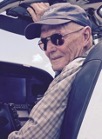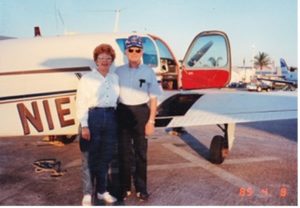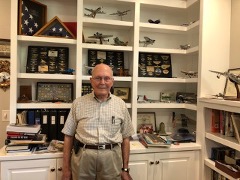Craig Kern
ATP / MEL; Commercial ASEL & SES;
CFI-A M&I; GI-A&I; Gold Seal Flight Instructor
12,000 flight hours / 8,600 instruction hours
BPT: What first attracted you to aviation – and why?
CK: My father was a pioneer Eastern Air Lines Captain. The experiences he shared piqued my interest in aviation.
BPT: Craig, when and where did you learn to fly?
CK: I learned to fly at the Richards-Gebaur AFB, MO Aero Club in 1958 in an Aeronca Champ.
BPT: Sounds exciting. Since then, which aircraft have you flown?
CK: It’s a long list! I’ve flown everything from a Beechcraft Sundowner to a Sierra, Bonanzas, Barons, King Airs, AT-11s, T-34s; Cessna 150s, 172s, 182s, 207s, 210s, 402s, 421s; Aeronca Champs; Decathlons; Ryan Navions; Fairchild Swearingen Metroliners; Cirrus SR-22s; Piper PA-23s, PA-24s; PA-28 series, PA-30s; PA-31s; PA-32s, PA-34s and PA-38s.
BPT: That’s impressive! What are you currently flying?
CK: Currently I fly other people’s airplanes while providing instruction.
BPT: What are the highlights of your career?
CK: I learned to fly in the Air Force Aero Club system, which is very regulatory. After I retired from the military in 1978, I flew night freight in a Swearingen Metroliner for several months before returning to federal civil service at Wright-Patterson AFB, OH [WPAFB] Aero Club.
I retired from civil service in 1999 and flew part-time for an on-demand charter operator, while I instructed at the WPAFB Aero Club.
In 2003, I established a speed record from Huffman Prairie in Dayton, OH to Kill Devils Hill, NC in a Baron. I became the WPAFB Chief Flight Instructor in 2007 until it was closed in 2012.
An FBO at a nearby airport was looking for an Aero Club so we moved the management, instructors and most members to that location. I was the Chief Flight Instructor, as we started to reform the organization into a Part 141 Flight School and acquire aircraft over the years to support the organization. I retired from that organization in 2019.
BPT: Tell us how you became involved with BPT.
CK: The Chief Flight Instructor at Wright-Patterson AFB introduced me to BPT (then, BPPP) in 1995 when we both owned Bonanzas.
BPT: Tell us, Craig, why BPT is important to you.
CK: BPT allows a group of very knowledgeable instructors to provide their wisdom and experience with Beechcraft pilots, so that those pilots can operate their aircraft more safely.
BPT: What do you think makes BPT unique?
CK: The ability for Beechcraft pilots to communicate with others and to share their experiences and learn what went right and what was ‘not so right’ (been there, done that), as well as to improve their level of proficiency.

BPT: Would you recommend BPT to a new pilot? If so, why?
CK: As Bonanza / Baron specialists, we provide insights on how to obtain the best performance in an efficient manner from the aircraft. We also provide nuances of the aircraft systems to inform the pilot so he or she can operate them better and handle abnormalities, should they occur.
BPT: How about for a seasoned pilot? Would you recommend BPT — and if so, why?
CK: Absolutely! We are constantly changing the curriculum to discuss relevant subjects to keep pilots up-to-date.
BPT: Is there anything else you would like to add?
CK: Flying is a constantly changing environment and no two flights are the same — from weather to ATC to everything in between. For a pilot to maintain currency — much less, proficiency — he or she needs to train. BPT offers the very best training for Beechcraft pilots, as attested by the many pilots who have attended our courses multiple times.






